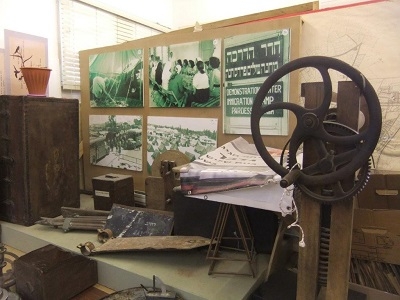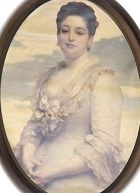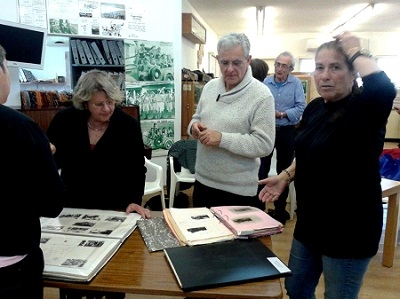Pardes Hanna Has a Museum
Photos & text: Lydia Aisenberg
A somewhat nondescript flat-roofed building, a bursting car park in the forecourt, sits perched on a slight rise of ground that is prime real estate in the center of the flourishing Israeli town of Pardes Hanna (the Orchard of Hanna).
These days, most people would not give the early 1930s-constructed building a second glance, but in those early Zionist settlement days it was a palace of local pride, the first kindergarten created by the pioneers - doubling, or rather tripling up as a synagogue, school room for first and second graders and sometimes rather high-spirited, raucous meetings of the community at large.
The multi-purpose building of yore is now a homely museum containing artifacts from Pardes Hanna's early settlement days and an extremely fascinating and enriching archive.
However, I soon discovered that the owners of the parked cars were not delving into the town's past as was I, but checking up on their present day personal state of affairs at the bank across the street!
Nowadays, Pardes Hanna almost physically joins nearby Karkur, the latter a community originally settled by determined Zionist pioneers from Britain in the early 1900s, where, today, one can find third generation Israelis with English and Welsh roots, as well as a sizeable population of British immigrants - veteran and new.
Apart from the ex-pat Brits, there are also other veteran, or relatively new, immigrants from English-speaking countries who settled in the town. They were attracted to the rural setting of the region, possible historical family connections and in more recent times, the excellent train service to major cities in the north and south of the country, which definitely has been part of the draw to the region.
Karkur, founded in 1926, and Pardes Hanna, founded in 1929, were forced to amalgamate in 1969. However, even though they have a shared local council physically situated in Pardes Hanna, many Karkurians see themselves as together, separately. So much so, in fact, that as I discovered during my time in the museum, when that late 1960s merger was enacted, the folks of Karkur donated their archives to the national archives and not to that of Pardes Hanna - just to show the neighbors how much they disagreed with the forced-upon-them-by-government merger.
Residents of Pardes Hanna-Karkur, when telling you where they are from, rarely put the two together … they are either from Pardes Hanna or from Karkur. "Shotgun weddings leave a bitter taste in the mouth," I was recently told by a veteran of Karkur who also joked that he sometimes called his home Parkur.
In the Pardes Hanna museum,,large sepia photographs of the early settlers adorn the walls. Arranged in clusters around the museum, large and small artifacts, ranging from the most basic farming tools to the smallest of kitchen utensils, are on display.
An ominous-looking massive iron-framed, wooden roller mangle used to wring out laundry certainly kicks the imagination into immediate action – the huffing and puffing of the operator almost audible as they would have struggled to squeeze as much moisture as possible out of the hand-washed clothing and linens, all of which were in short supply and necessitated a quick turnaround.
Another section of the museum houses rows of metal cabinets, work tables and computers manned by local volunteers (on the books over 40 in number and mostly over 60 in age). They diligently work at indexing the plethora of photographs, paperwork – manuscripts, reports, letters - and the recorded in writing, sound and film stories of the individual founding fathers and the families born unto them as they struggled to succeed in turning swamps into farmland, and to provide for their offspring. They made history as they survived the harshest of elements and the sometimes conflicting ideologies of fellow pioneers of the period.
Neatly filed away and slowly being computerized by seven volunteers, members of a not-for-profit organization they set up to keep the past alive, is almost a century of records.
These include some amazing material from the British Mandate period as well as the pioneers' vivid descriptions of daily life, their constant struggle in taking on the seemingly insurmountable challenges and relentless hardships. Although there is much heartache put down in writing, there are also heartening descriptions of successes, of frugal celebrations within the community, of their dogged determination not to give up, driven by sheer stubbornness to create a country for the Jewish people, spurring them on, and at a later stage, a sharing of pride in the achievement of that goal.
A small group of English-speaking residents of Pardes Hanna-Karkur and environs, mostly retiree members of the local branch of the countrywide English Speaking Residents Association (ESRA), have come to hear about the museum and archives from Telma Levy, a Pardes Hanna native and one of the local volunteers.
A retired school teacher, Telma explains about a group of Eastern European Jews who fled poverty and pogroms to settle in Britain and America in the early 1900s, some of whom dreamed of continuing their journey on to the Promised Land - and succeeding.
"Among the group there were those who collected money in order to purchase land from Arab owners in Ottoman-ruled Palestine," explained Telma, who donated her personal collection of books relating to the founders and development of the region to the museum, often visited by special interest groups such as ESRA, students and children.
Already in 1913, Arab landowners from Haifa and Jenin – a present-day northern West Bank autonomous city under the Palestinian Authority – had sold some 15 square kilometers of land that eventually became Karkur, Pardes Hanna and a number of cooperative farming communities. The original buyers were an organization known as Hachsharat Hayishuv but the land was relatively quickly sold on in parcels to land developer Yitzhak Shlezinger, the Odessa Committee and the London Ahuza Society – where the money-collecting Zionists in Britain came in.
Shlezinger went bankrupt, sold his share to the Jewish National Fund (JNF) who then, together with the London Ahuza Society, founded Karkur. An interesting head count conducted by the British Mandatory authorities in 1922 accredited the community with a rather meager population - just 38, three of whom were Muslims. Figures at the Karkur centenary in 1963 are on record as 3,400, and the Pardes Hanna-Karkur council today gives 38,000 as the two-in-one town's population.
Named after the daughter of Nathan Mayer Rothschild, Pardes Hanna was established in 1929 by yet another organization, the Palestine Jewish Colonization Association – and the rest is, as they say, history.
As Telma shares the story of the pioneers and the development of Pardes Hanna, high on the wall behind her a large, oval, framed portrait of a woman in a low-necked but rather frilly dress, a somewhat whimsical expression on her face, gazes down from high on those gathered for the talk and walk around below.
The woman in the frame is of course Hannah Rothschild, and what could be more fitting than having her, from above so to speak, continue to share in the story of, and today's pride in, the successful town that bears her name.











Comments